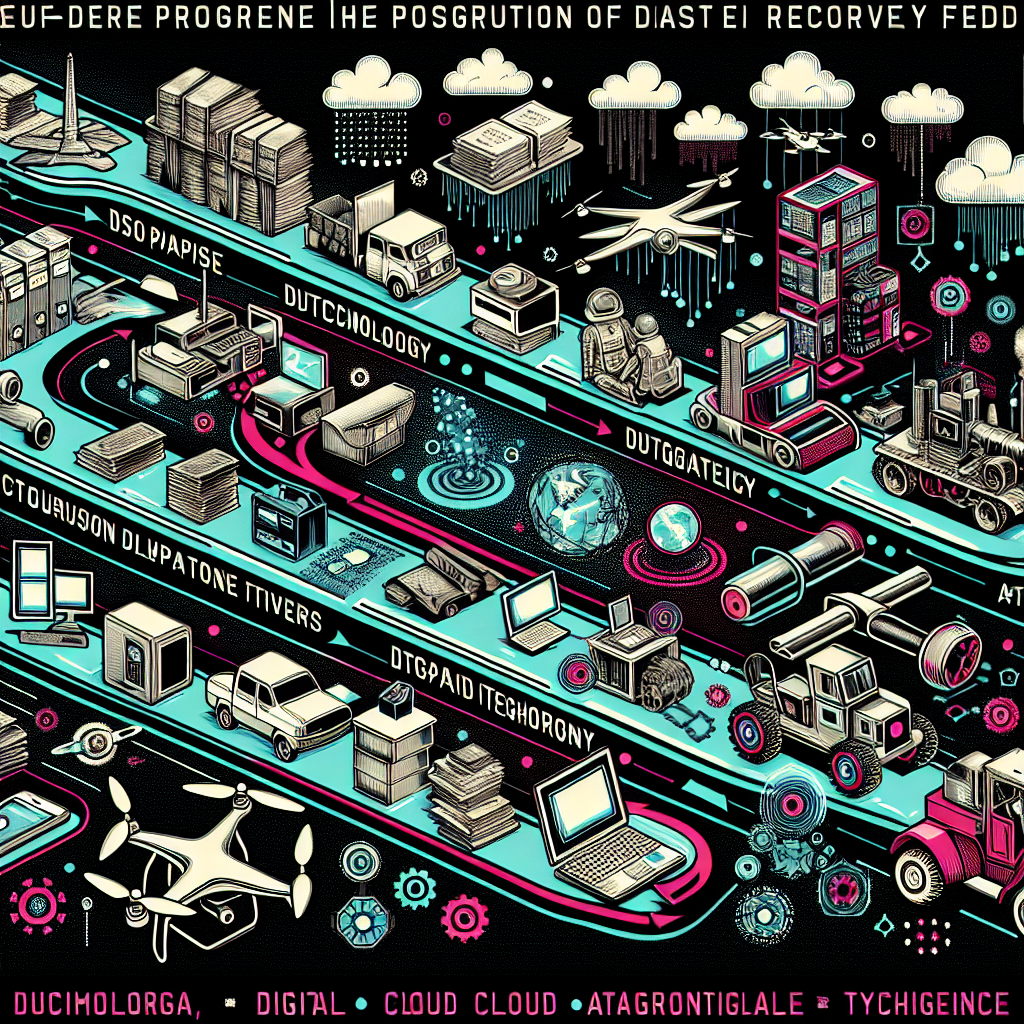Your cart is currently empty!
Tag: Disaster Recovery
How to Create an Effective Disaster Recovery Plan
Disasters can strike at any time, whether it be a natural disaster like a hurricane or earthquake, or a man-made disaster such as a cyber attack or data breach. In order to protect your business and ensure its continuity in the face of such events, it is essential to have a well-thought-out disaster recovery plan in place.Creating an effective disaster recovery plan requires careful planning and consideration of all possible scenarios. Here are some steps to help you create a comprehensive and effective disaster recovery plan for your business:
1. Identify potential risks: The first step in creating a disaster recovery plan is to identify the potential risks that your business may face. This could include natural disasters, such as floods or fires, as well as man-made disasters like cyber attacks or data breaches. By understanding the specific threats that your business faces, you can better prepare for them and mitigate their impact.
2. Assess the impact: Once you have identified the potential risks, it is important to assess the potential impact that these disasters could have on your business. This includes considering the financial, operational, and reputational consequences of a disaster, as well as the potential impact on your employees and customers.
3. Develop a plan: Based on your risk assessment, develop a comprehensive disaster recovery plan that outlines how your business will respond to different types of disasters. This plan should include detailed procedures for how to mitigate the impact of a disaster, as well as how to recover and resume business operations as quickly as possible.
4. Establish communication protocols: Communication is key during a disaster, so it is important to establish clear communication protocols for notifying employees, customers, and other stakeholders in the event of a disaster. Make sure that everyone knows their roles and responsibilities and how to stay in touch during a crisis.
5. Test and update the plan: Once you have developed your disaster recovery plan, it is important to test it regularly to ensure that it is effective and up-to-date. Conduct regular drills and exercises to simulate different disaster scenarios and identify any gaps or weaknesses in your plan. Make sure to update your plan as your business grows and changes, and as new risks emerge.
By following these steps and creating an effective disaster recovery plan, you can help protect your business and ensure its continuity in the face of any disaster. Remember, preparation is key when it comes to disaster recovery, so take the time to develop a plan that works for your business and be ready to act quickly and decisively in the event of a crisis.

Preparing for the Unexpected: How to Test and Update Your Disaster Recovery Plan
In today’s fast-paced world, businesses are constantly facing new challenges and threats that can disrupt their operations. From natural disasters to cyber-attacks, there are countless potential risks that can impact a company’s ability to function effectively. That’s why having a solid disaster recovery plan in place is essential for every organization.A disaster recovery plan is a set of procedures and protocols that a business puts in place to ensure that it can continue to operate in the event of a disaster. This could be anything from a power outage to a major data breach. By having a plan in place, companies can minimize the impact of these events and ensure that they can quickly recover and get back to business as usual.
However, simply having a disaster recovery plan is not enough. It’s also important to regularly test and update the plan to ensure that it remains effective and relevant. Here are some tips for preparing for the unexpected by testing and updating your disaster recovery plan:
1. Conduct regular testing: One of the most important steps in preparing for the unexpected is to regularly test your disaster recovery plan. This could involve running simulations of various disaster scenarios to see how well your plan holds up. By conducting regular tests, you can identify any weaknesses or gaps in your plan and make necessary adjustments.
2. Review and update your plan: As your business grows and evolves, so too should your disaster recovery plan. It’s important to regularly review and update your plan to ensure that it reflects the current state of your business and any new potential risks that may have emerged. This could involve revising your contact lists, updating your recovery procedures, or implementing new technologies to enhance your disaster recovery capabilities.
3. Train your team: In the event of a disaster, your team will be instrumental in implementing your disaster recovery plan. That’s why it’s important to ensure that everyone is well-trained and familiar with their roles and responsibilities in the event of a disaster. By conducting regular training sessions, you can ensure that your team is prepared to respond effectively in an emergency.
4. Communicate with stakeholders: It’s also important to keep key stakeholders informed about your disaster recovery plan and any updates or changes that have been made. This could include employees, customers, suppliers, and other partners who may be impacted by a disaster. By keeping everyone in the loop, you can ensure a coordinated and effective response to any unexpected events.
In conclusion, preparing for the unexpected is essential for every business. By testing and updating your disaster recovery plan regularly, you can ensure that your organization is well-equipped to handle any potential threats that may arise. With a solid plan in place, you can minimize the impact of disasters and ensure that your business can quickly recover and continue to thrive.

The Evolution of Disaster Recovery: Trends and Innovations in the Field
Disaster recovery has always been an essential aspect of business continuity planning. As technology continues to advance, the field of disaster recovery has also evolved to keep pace with the changing landscape of potential threats and risks. In recent years, there have been several trends and innovations that have transformed the way organizations approach disaster recovery.One of the most significant trends in disaster recovery is the shift towards cloud-based solutions. Cloud computing offers a cost-effective and scalable way to store and backup data, making it an attractive option for organizations looking to enhance their disaster recovery capabilities. By leveraging the cloud, businesses can ensure that their critical data is always accessible and secure, even in the event of a disaster.
Another key trend in disaster recovery is the adoption of virtualization technology. Virtualization allows organizations to create virtual copies of their servers and applications, making it easier to recover data and systems in the event of a disaster. Virtualization also enables businesses to test their disaster recovery plans more effectively, ensuring that they are prepared for any potential scenario.
In addition to these trends, there have been several innovations in the field of disaster recovery that are reshaping the way organizations approach resilience planning. One such innovation is the use of artificial intelligence and machine learning to improve disaster recovery processes. These technologies can help organizations identify potential threats and vulnerabilities, automate recovery processes, and analyze data to improve overall resilience.
Another innovation in disaster recovery is the use of data analytics to improve decision-making and response times during a disaster. By analyzing historical data and trends, organizations can better predict potential risks and develop more effective recovery strategies. Data analytics can also help organizations identify areas for improvement in their disaster recovery plans, ensuring that they are always prepared for any eventuality.
As the field of disaster recovery continues to evolve, it is essential for organizations to stay ahead of the curve and embrace these trends and innovations. By leveraging cloud-based solutions, virtualization technology, artificial intelligence, and data analytics, businesses can enhance their resilience and ensure that they are prepared for any disaster that may come their way. The evolution of disaster recovery is an ongoing process, and organizations that adapt and innovate will be better equipped to navigate the challenges of an increasingly complex and unpredictable world.

Disaster Recovery in the Cloud: Leveraging Technology for Business Continuity
In today’s fast-paced business landscape, it is crucial for organizations to have a robust disaster recovery plan in place to ensure business continuity in the event of a disaster. With the increasing reliance on technology in day-to-day operations, leveraging cloud technology for disaster recovery has become a popular choice for many businesses.Disaster recovery in the cloud involves storing critical data and applications in a secure, off-site location that can be accessed in the event of a disaster. This allows businesses to quickly recover and resume operations with minimal downtime, minimizing the impact on productivity and revenue.
One of the key advantages of leveraging cloud technology for disaster recovery is the flexibility and scalability it offers. Cloud-based solutions can easily be scaled up or down based on the needs of the business, allowing organizations to tailor their disaster recovery plans to meet their specific requirements. This flexibility also enables businesses to quickly adapt to changing circumstances and ensure that their critical data and applications are always protected and accessible.
Cloud-based disaster recovery solutions also offer improved reliability and security compared to traditional on-premise solutions. Cloud providers typically have multiple data centers located in different geographical locations, ensuring that data is replicated and stored in multiple locations for added redundancy. This redundancy reduces the risk of data loss and ensures that critical data and applications are always available when needed.
Furthermore, cloud providers invest heavily in cybersecurity measures to protect data from threats such as hacking, malware, and ransomware. This level of security is often beyond the capabilities of many small to medium-sized businesses, making cloud-based disaster recovery an attractive option for organizations looking to enhance their data protection measures.
Another benefit of leveraging cloud technology for disaster recovery is cost-effectiveness. Traditional disaster recovery solutions often require significant upfront investment in hardware, software, and infrastructure, as well as ongoing maintenance and management costs. Cloud-based solutions, on the other hand, operate on a pay-as-you-go model, allowing businesses to only pay for the resources they use. This can result in significant cost savings for organizations, particularly smaller businesses with limited IT budgets.
In conclusion, disaster recovery in the cloud offers businesses a cost-effective, scalable, and secure solution for ensuring business continuity in the event of a disaster. By leveraging cloud technology, organizations can protect their critical data and applications, minimize downtime, and ensure that they can quickly recover and resume operations, no matter what challenges they may face. With the increasing importance of technology in today’s business environment, investing in cloud-based disaster recovery is a smart choice for organizations looking to safeguard their data and maintain business continuity in an increasingly uncertain world.

Ensuring Data Security and Compliance in Disaster Recovery Plans
In today’s digital age, data security and compliance are two critical components that organizations must consider when developing disaster recovery plans. The increasing frequency and complexity of cyber threats, along with stringent regulatory requirements, make it imperative for businesses to prioritize the protection of sensitive data and ensure compliance with relevant laws and regulations.One of the first steps in ensuring data security and compliance in disaster recovery plans is to conduct a thorough risk assessment. This involves identifying potential threats and vulnerabilities that could compromise the confidentiality, integrity, and availability of data. By understanding the risks facing the organization, businesses can develop strategies to mitigate these risks and strengthen their overall cybersecurity posture.
Another key aspect of data security and compliance in disaster recovery plans is ensuring that data is adequately backed up and stored securely. Organizations should implement robust backup procedures to ensure that critical data is regularly backed up and stored in multiple locations, including offsite or in the cloud. Additionally, encryption should be used to protect data both in transit and at rest, to prevent unauthorized access in the event of a breach.
Compliance with relevant laws and regulations is also essential when developing disaster recovery plans. Different industries are subject to specific data protection regulations, such as the Health Insurance Portability and Accountability Act (HIPAA) for healthcare organizations or the General Data Protection Regulation (GDPR) for businesses operating in the European Union. Organizations must ensure that their disaster recovery plans are in compliance with these regulations to avoid potential fines and legal consequences.
Regular testing and monitoring of disaster recovery plans are crucial to ensure their effectiveness in the event of a data breach or other disaster. Organizations should conduct regular drills and simulations to test the response and recovery procedures outlined in their plans. Additionally, continuous monitoring of network activity and data access can help detect any suspicious behavior or potential security incidents, allowing organizations to respond promptly and minimize the impact on data security.
In conclusion, ensuring data security and compliance in disaster recovery plans is essential for organizations to protect sensitive data and maintain regulatory compliance. By conducting risk assessments, implementing secure backup procedures, and ensuring compliance with relevant laws and regulations, businesses can strengthen their overall cybersecurity posture and be better prepared to respond to potential threats and disasters. Regular testing and monitoring of disaster recovery plans are also critical to ensure their effectiveness and reliability in the face of evolving cyber threats.

The True Cost of Not Having a Disaster Recovery Plan in Place
In today’s digital age, businesses rely heavily on their data and IT systems to operate efficiently and effectively. However, many companies fail to recognize the importance of having a disaster recovery plan in place until it’s too late. The true cost of not having a disaster recovery plan can be devastating, both financially and in terms of reputation.First and foremost, the financial cost of not having a disaster recovery plan can be significant. In the event of a data breach, system failure, or natural disaster, businesses may lose valuable data, experience downtime, and incur additional expenses to recover and rebuild their systems. According to a study by the Ponemon Institute, the average cost of a data breach in 2020 was $3.86 million, with costs increasing for larger organizations. Without a disaster recovery plan in place, businesses risk losing revenue, customers, and even going out of business altogether.
Furthermore, the reputational cost of not having a disaster recovery plan can be equally damaging. In today’s highly competitive market, customers expect businesses to protect their data and ensure the continuity of their services. A data breach or system failure can lead to negative publicity, loss of customer trust, and damage to a company’s reputation. This can result in long-term consequences, including loss of customers, difficulty attracting new business, and ultimately, a decline in revenue.
In addition to the financial and reputational costs, businesses without a disaster recovery plan may also face legal and regulatory repercussions. With the increasing emphasis on data privacy and security laws, such as the General Data Protection Regulation (GDPR) and the California Consumer Privacy Act (CCPA), companies are required to protect and secure their data. Failure to do so can result in costly fines, lawsuits, and legal penalties.
Overall, the true cost of not having a disaster recovery plan in place can be catastrophic for businesses. It is essential for companies to invest in a comprehensive and effective disaster recovery plan to protect their data, systems, and reputation. By proactively preparing for potential disasters and implementing a robust recovery plan, businesses can mitigate the risks and ensure the continuity of their operations in the face of unforeseen events. Remember, it’s not a matter of if a disaster will strike, but when – so it’s better to be prepared than to suffer the consequences of being caught off guard.

3 Key Steps to Creating a Resilient Disaster Recovery Plan
In today’s unpredictable world, it’s more important than ever for businesses to have a resilient disaster recovery plan in place. Natural disasters, cyberattacks, and other unforeseen events can wreak havoc on a company’s operations and finances. Having a solid disaster recovery plan can help businesses minimize downtime, protect their data, and ensure a quick recovery in the event of a crisis.Here are three key steps to creating a resilient disaster recovery plan:
1. Conduct a thorough risk assessment: The first step in creating a disaster recovery plan is to identify potential risks and vulnerabilities that could impact your business. This includes natural disasters such as hurricanes, earthquakes, and floods, as well as cybersecurity threats like ransomware attacks and data breaches. Consider conducting a risk assessment to evaluate the likelihood and potential impact of these events on your business. This will help you prioritize your efforts and resources to address the most critical risks.
2. Develop a comprehensive plan: Once you have identified the risks, it’s important to develop a comprehensive disaster recovery plan that outlines how your business will respond and recover in the event of a crisis. This plan should include detailed procedures for mitigating risks, protecting data, and restoring operations. It should also establish clear roles and responsibilities for key personnel and outline communication protocols for keeping employees, customers, and stakeholders informed during a crisis.
3. Test and update regularly: A disaster recovery plan is only effective if it is regularly tested and updated to ensure its effectiveness. Conducting regular drills and simulations can help identify gaps in your plan and allow you to make necessary adjustments. It’s also important to stay informed about emerging threats and technologies that could impact your business and update your plan accordingly. By regularly testing and updating your disaster recovery plan, you can ensure that your business is prepared to handle any crisis that comes its way.
In conclusion, creating a resilient disaster recovery plan is essential for businesses to protect themselves from unforeseen events and ensure a quick recovery in the event of a crisis. By conducting a thorough risk assessment, developing a comprehensive plan, and regularly testing and updating it, businesses can minimize downtime, protect their data, and maintain their operations during a crisis. Investing in a resilient disaster recovery plan is a smart decision that can ultimately save your business time, money, and reputation in the long run.

Disaster Recovery Strategies for Businesses: How to Stay Prepared
Disasters can strike at any time, and businesses need to be prepared in order to minimize the impact of these events on their operations. Whether it’s a natural disaster like a hurricane or earthquake, or a man-made disaster like a cyberattack or data breach, having a solid disaster recovery plan in place is essential for businesses of all sizes.Here are some key strategies for businesses to stay prepared in the face of a disaster:
1. Identify Risks: The first step in creating a disaster recovery plan is to identify the potential risks that your business faces. This could include natural disasters, such as floods, fires, or earthquakes, as well as man-made disasters like cyberattacks or data breaches. By understanding the risks, you can better prepare for them and develop a plan to mitigate their impact.
2. Create a Plan: Once you have identified the risks, it’s important to create a comprehensive disaster recovery plan. This should outline the steps that your business will take in the event of a disaster, including how you will communicate with employees, customers, and suppliers, how you will secure your data and systems, and how you will continue to operate during and after the disaster.
3. Backup Data: One of the most important aspects of a disaster recovery plan is backing up your data. This includes both on-site and off-site backups, so that you can quickly restore your data in the event of a disaster. Regularly backing up your data and testing your backups is essential to ensure that you can quickly recover from a disaster.
4. Secure Your Systems: In addition to backing up your data, it’s important to secure your systems to prevent cyberattacks and data breaches. This includes implementing strong passwords, regularly updating software and security patches, and training employees on cybersecurity best practices.
5. Test Your Plan: Once you have created a disaster recovery plan, it’s important to regularly test it to ensure that it will work in the event of a disaster. This could include running simulations of various disaster scenarios, testing your backups, and conducting drills with employees to ensure that everyone knows their roles and responsibilities.
By following these strategies, businesses can stay prepared in the face of a disaster and minimize the impact on their operations. Being proactive and having a solid disaster recovery plan in place can give businesses the confidence that they can quickly recover from a disaster and continue to serve their customers.

The Importance of Disaster Recovery Planning: A Comprehensive Guide
In today’s digital age, businesses rely heavily on technology to operate efficiently and effectively. From storing important data to communicating with clients and customers, technology plays a crucial role in the day-to-day operations of any organization. However, with the increasing reliance on technology comes the risk of disasters that can disrupt business operations and cause significant financial losses. This is where disaster recovery planning becomes essential.Disaster recovery planning is the process of creating a strategy to ensure that a business can continue to operate in the event of a disaster, such as a cyberattack, natural disaster, or system failure. This comprehensive guide will outline the importance of disaster recovery planning and provide tips on how to create an effective plan for your business.
One of the main reasons why disaster recovery planning is so important is that it helps businesses minimize downtime and recover quickly from any disruptions. In the event of a disaster, every minute that a business is unable to operate can result in lost revenue and damage to its reputation. By having a solid disaster recovery plan in place, businesses can ensure that they are able to resume operations as quickly as possible and minimize the impact of the disaster on their bottom line.
Additionally, disaster recovery planning helps businesses protect their valuable data and information. In today’s digital world, data is one of the most valuable assets that a business possesses. Losing important data can have serious consequences, including financial losses, legal issues, and damage to the business’s reputation. By creating a disaster recovery plan that includes regular backups and data recovery procedures, businesses can ensure that their data is safe and secure in the event of a disaster.
Furthermore, disaster recovery planning can help businesses comply with regulatory requirements and industry standards. Many industries have specific regulations that require businesses to have a disaster recovery plan in place to protect sensitive data and ensure business continuity. By creating a comprehensive disaster recovery plan, businesses can demonstrate to regulators and stakeholders that they are taking the necessary steps to protect their data and ensure business continuity in the event of a disaster.
So, how can businesses create an effective disaster recovery plan? Here are some tips to get started:
1. Assess the risks: Identify potential threats and vulnerabilities that could disrupt your business operations, such as cyberattacks, natural disasters, and system failures.
2. Define your objectives: Clearly define the goals and objectives of your disaster recovery plan, including the desired recovery time and recovery point objectives.
3. Develop a strategy: Create a detailed plan that outlines the steps to be taken in the event of a disaster, including data backup procedures, recovery procedures, and communication protocols.
4. Test and update your plan: Regularly test your disaster recovery plan to ensure that it is effective and up to date. Make any necessary adjustments based on the results of your tests.
In conclusion, disaster recovery planning is a critical component of any business’s overall risk management strategy. By creating a comprehensive disaster recovery plan, businesses can protect their data, minimize downtime, and ensure business continuity in the event of a disaster. By following the tips outlined in this guide, businesses can create an effective disaster recovery plan that will help them weather any storm.

Lessons Learned: Real-World Examples of Effective Disaster Recovery Strategies
Disasters can strike at any moment, and it’s crucial for businesses to have effective disaster recovery strategies in place to minimize downtime and ensure business continuity. Learning from real-world examples of successful disaster recovery strategies can provide valuable insights on how to better prepare for emergencies and protect your organization’s assets.One example of an effective disaster recovery strategy is the case of Delta Airlines, which experienced a major power outage in August 2016 that led to the cancellation of thousands of flights. Despite the chaos and disruption caused by the outage, Delta was able to recover quickly and resume normal operations within a few days. This was largely due to the airline’s robust disaster recovery plan, which included backup power generators, redundant data centers, and a well-trained team of professionals who were able to quickly assess the situation and implement the necessary recovery measures.
Another notable example is the case of Target, which suffered a massive data breach in 2013 that exposed the personal information of millions of customers. In the aftermath of the breach, Target implemented a comprehensive disaster recovery plan that included enhanced cybersecurity measures, regular security audits, and employee training programs to prevent future breaches. By learning from their mistakes and taking proactive steps to improve their security protocols, Target was able to rebuild customer trust and recover from the incident.
In addition to these examples, there are many other real-world cases that highlight the importance of having effective disaster recovery strategies in place. Whether it’s a natural disaster, a cyber attack, or a technical failure, being prepared for emergencies can mean the difference between a minor inconvenience and a major catastrophe for your business.
So, what are some key lessons that can be learned from these real-world examples of effective disaster recovery strategies?
First and foremost, it’s essential to have a comprehensive disaster recovery plan in place that is regularly updated and tested. This plan should include detailed procedures for responding to emergencies, identifying critical assets, and communicating with stakeholders. By having a clear roadmap for how to handle disasters, organizations can minimize confusion and ensure a swift and effective response.
Secondly, investing in robust technology infrastructure and security measures is crucial for protecting your organization’s data and operations. This includes implementing backup systems, data encryption, and firewalls to prevent breaches and ensure data integrity. By staying ahead of the curve in terms of technology, businesses can better protect themselves from cyber threats and other disasters.
Lastly, having a well-trained and dedicated team of professionals who are prepared to handle emergencies is essential for successful disaster recovery. By providing employees with regular training and resources, organizations can empower their staff to respond quickly and effectively to disasters, minimizing the impact on operations and customer service.
In conclusion, learning from real-world examples of effective disaster recovery strategies can provide valuable insights on how to better prepare for emergencies and protect your organization’s assets. By implementing comprehensive disaster recovery plans, investing in technology infrastructure, and training employees to respond to emergencies, businesses can mitigate risks and ensure business continuity in the face of disasters.
